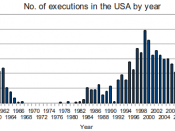The theory 'a life for a life' is 'as old as civilization itself' (McCiellan 9). The
development of civilizations established what we call justice today. Capital punishment, the
execution of a criminal convicted of a crime, or the legal taking of the life of a criminal,
can be divided into three categories: first, crimes against the person; second, crimes against
property; and third, crimes which endanger the security of the nation (Horwitz 13). Capital
punishment is still in use in the United States today, but has been abolished by many countries
(II 536). The countries that still have the death penalty on their books, rarely employ it .
The earliest writings on the subject dates as far back as 2000 B. C., but it is clear
that capital punishment more or less has existed since the birth of mankind (Szumski 25).
Throughout history, it has been exercised in almost all civilizations as a retribution for
severe crimes, but sometimes also for the thrill and excitement.
The Romans put slaves and
prisoners in the Coliseum as lion food while spectators enjoyed the sight (Horwitz 13).
Birger 2
In the early colonial states, the death penalty was applied for a vast number of crimes,
just like in England, the ruler of the states in this era (II 536). In England, in the 18th
century, there were approximately 220 offenses punishable by death. Some of them would today be
considered as misdemeanors and petty crimes (i. e. shooting of a rabbit, the theft of a pocket
handkerchief, and to cut down a cherry tree) (Horwitz 13). The majority of these were crimes
dealing with property. However, transportation became an alternative to execution in the 17th
century. A lot of these criminals were shipped to the U.S. (28).
In the early days of our...


